总结
参考
菜菜的sklearn课堂——随机森林
傻子都能看懂的——详解AdaBoost原理
算法使用过程
#导入数据集模块
from sklearn import datasets
#分别加载iris和digits数据集
iris = datasets.load_iris() #鸢尾花数据集
# print(dir(datasets))
# print(iris_dataset.keys())
# dict_keys(['data', 'target', 'frame', 'target_names', 'DESCR', 'feature_names', 'filename', 'data_module'])from sklearn.model_selection import train_test_split
X_train,X_test,y_train,y_test=train_test_split(iris.data,iris.target,test_size=0.4,random_state=0)
print("iris.data[0:5]:\n",iris.data[0:5])
print("iris.target[0:5]:\n",iris.target[0:5])
print("iris.data.shape:",iris.data.shape)
print("iris.target.shape:",iris.target.shape)
print("X_train.shape:",X_train.shape)
print("y_train.shape:",y_train.shape)
print("X_test.shape:",X_test.shape)
print("y_test.shape:",y_test.shape)# 第二步使用sklearn模型的选择
from sklearn import svm
svc = svm.SVC(gamma='auto')#第三步使用sklearn模型的训练
svc.fit(X_train, y_train)# 第四步使用sklearn进行模型预测
print(svc.predict([[5.84,4.4,6.9,2.5]]))#第五步机器学习评测的指标
#机器学习库sklearn中,我们使用metrics方法实现:
import numpy as np
from sklearn.metrics import accuracy_score
print("y_test:\n",y_test)
y_pred = svc.predict(X_test)
print("y_pred:\n",y_pred)
print(accuracy_score(y_test, y_pred))#第五步机器学习评测方法:交叉验证 (Cross validation)
#机器学习库sklearn中,我们使用cross_val_score方法实现:
from sklearn.model_selection import cross_val_score
scores = cross_val_score(svc, iris.data, iris.target, cv=5)
print(scores)#第六步机器学习:模型的保存
#机器学习库sklearn中,我们使用joblib方法实现:
# from sklearn.externals import joblib
import joblib
joblib.dump(svc, 'filename.pkl')
svc1 = joblib.load('filename.pkl')
#测试读取后的Model
print(svc1.score(X_test, y_test))
输出为:
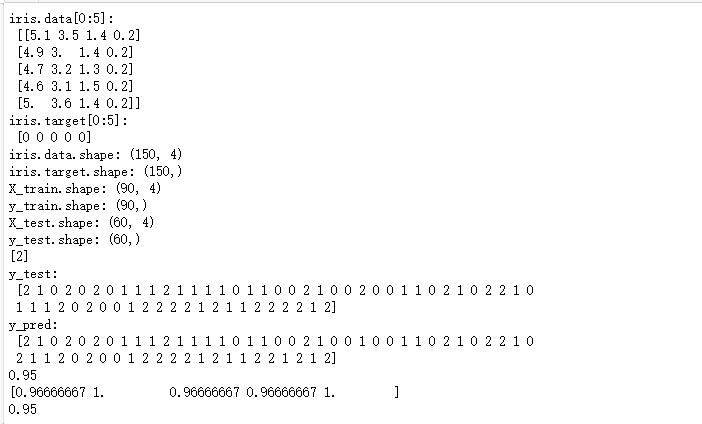
集成学习
集成算法会考虑多个评估器的建模结果,汇总之后得到一个综合的结果,以此来获取比单个模型更好的回归或分类表现。
sklearn中的集成算法模块ensemble
| 类 | 类的功能 |
|---|---|
| ensemble.AdaBoostClassifier | AdaBoost分类 |
| ensemble.AdaBoostRegressor | Adaboost回归 |
| ensemble.BaggingClassifier | 装袋分类器 |
| ensemble.BaggingRegressor | 装袋回归器 |
| ensemble.ExtraTreesClassifier | Extra-trees分类(超树,极端随机树) |
| ensemble.ExtraTreesRegressor | Extra-trees回归 |
| ensemble.GradientBoostingClassifier | 梯度提升分类 |
| ensemble.GradientBoostingRegressor | 梯度提升回归 |
| ensemble.IsolationForest | 隔离森林 |
| ensemble.RandomForestClassifier | 随机森林分类 |
| ensemble.RandomForestRegressor | 随机森林回归 |
| ensemble.RandomTreesEmbedding | 完全随机树的集成 |
| ensemble.VotingClassifier | 用于不合适估算器的软投票/多数规则分类器 |
Bagging和Boosting都是将已有的分类或回归算法通过一定方式组合起来,形成一个性能更加强大的分类器,更准确的说这是一种分类算法的组装方法。即将弱分类器组装成强分类器的方法。
首先介绍Bootstraping,即自助法:它是一种有放回的抽样方法(可能抽到重复的样本)。
1、Bagging (bootstrap aggregating)
Bagging即套袋法,其算法过程如下:
A)从原始样本集中抽取训练集。每轮从原始样本集中使用Bootstraping的方法抽取n个训练样本(在训练集中,有些样本可能被多次抽取到,而有些样本可能一次都没有被抽中)。共进行k轮抽取,得到k个训练集。(k个训练集之间是相互独立的)
B)每次使用一个训练集得到一个模型,k个训练集共得到k个模型。(注:这里并没有具体的分类算法或回归方法,我们可以根据具体问题采用不同的分类或回归方法,如决策树、感知器等)
C)对分类问题:将上步得到的k个模型采用投票的方式得到分类结果;对回归问题,计算上述模型的均值作为最后的结果。(所有模型的重要性相同)
2、Boosting
其主要思想是将弱分类器组装成一个强分类器。在PAC(概率近似正确)学习框架下,则一定可以将弱分类器组装成一个强分类器。
关于Boosting的两个核心问题:
1)在每一轮如何改变训练数据的权值或概率分布?
通过提高那些在前一轮被弱分类器分错样例的权值,减小前一轮分对样例的权值,来使得分类器对误分的数据有较好的效果。
2)通过什么方式来组合弱分类器?
通过加法模型将弱分类器进行线性组合,比如AdaBoost通过加权多数表决的方式,即增大错误率小的分类器的权值,同时减小错误率较大的分类器的权值。
而提升树通过拟合残差的方式逐步减小残差,将每一步生成的模型叠加得到最终模型。
3、Bagging,Boosting二者之间的区别
Bagging和Boosting的区别:
1)样本选择上:
Bagging:训练集是在原始集中有放回选取的,从原始集中选出的各轮训练集之间是独立的。
Boosting:每一轮的训练集不变,只是训练集中每个样例在分类器中的权重发生变化。而权值是根据上一轮的分类结果进行调整。
2)样例权重:
Bagging:使用均匀取样,每个样例的权重相等
Boosting:根据错误率不断调整样例的权值,错误率越大则权重越大。
3)预测函数:
Bagging:所有预测函数的权重相等。
Boosting:每个弱分类器都有相应的权重,对于分类误差小的分类器会有更大的权重。
4)并行计算:
Bagging:各个预测函数可以并行生成
Boosting:各个预测函数只能顺序生成,因为后一个模型参数需要前一轮模型的结果。
4、总结
这两种方法都是把若干个分类器整合为一个分类器的方法,只是整合的方式不一样,最终得到不一样的效果,将不同的分类算法套入到此类算法框架中一定程度上会提高了原单一分类器的分类效果,但是也增大了计算量。
下面是将决策树与这些算法框架进行结合所得到的新的算法:
1)Bagging + 决策树 = 随机森林RandomForestClassifier
2)AdaBoost + 决策树 = 提升树 AdaBoost
3)Gradient Boosting + 决策树 = GBDT
RandomForestClassifier
class sklearn.ensemble.RandomForestClassifier (n_estimators=’10’, criterion=’gini’, max_depth=None,
min_samples_split=2, min_samples_leaf=1, min_weight_fraction_leaf=0.0, max_features=’auto’,
max_leaf_nodes=None, min_impurity_decrease=0.0, min_impurity_split=None, bootstrap=True, oob_score=False,
n_jobs=None, random_state=None, verbose=0, warm_start=False, class_weight=None)
随机森林是非常具有代表性的Bagging集成算法,它的所有基评估器都是决策树,分类树组成的森林就叫做随机森林分类器,回归树所集成的森林就叫做随机森林回归器。这一节主要讲解RandomForestClassifier,随机森林分类器。
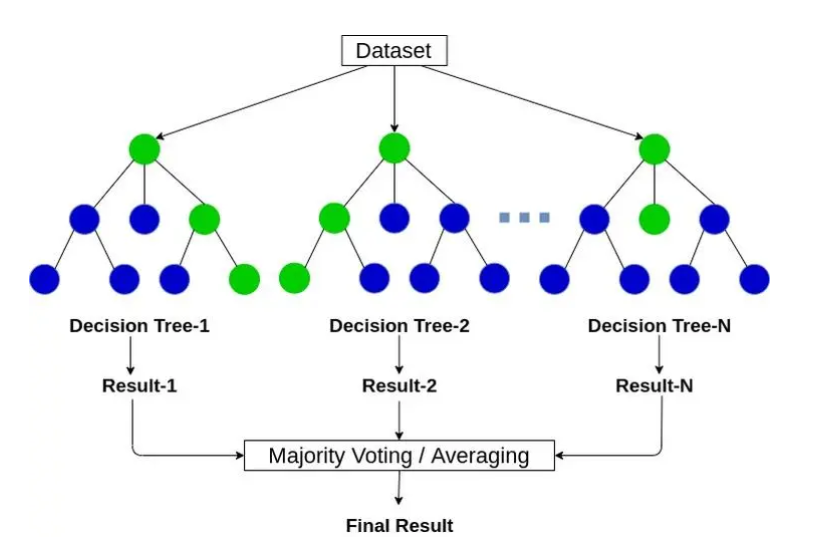
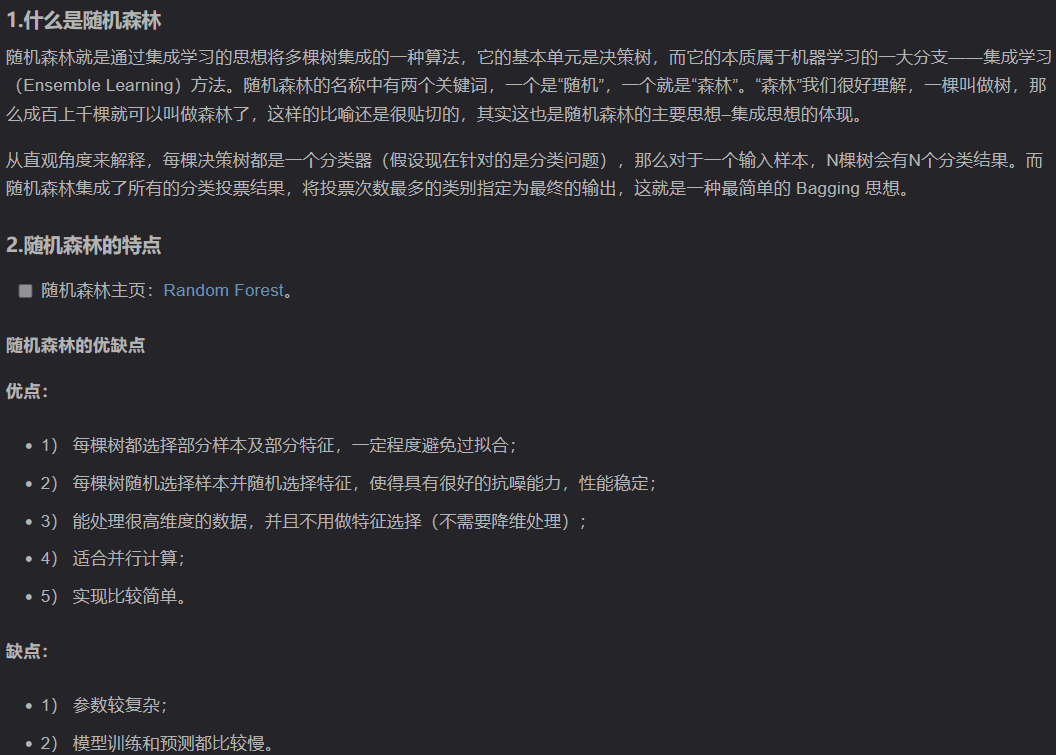
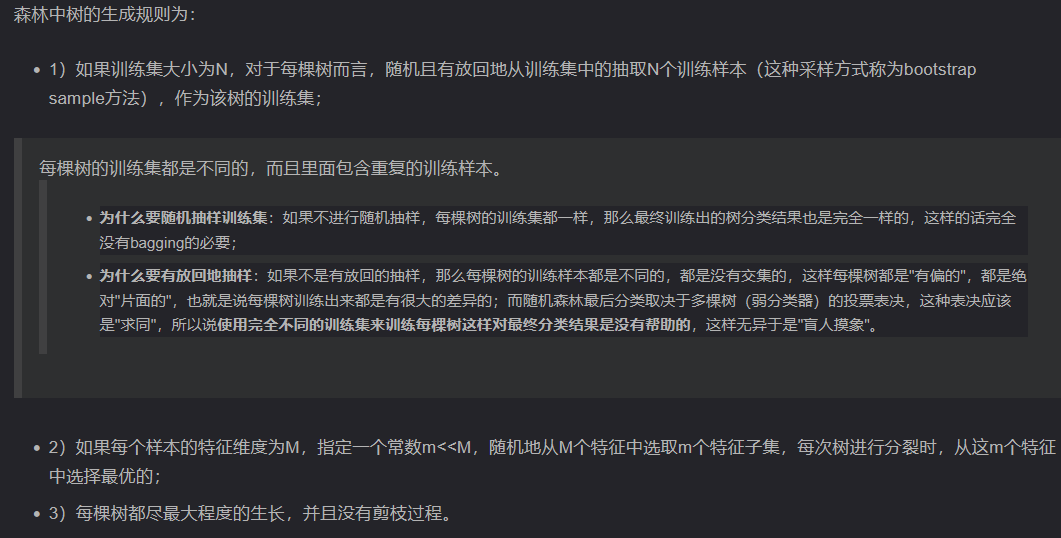
2.1 重要参数
2.1.1 控制基评估器的参数
| 参数 | 含义 |
|---|---|
| criterion | 不纯度的衡量指标,有基尼系数和信息熵两种选择 |
| max_depth | 树的最大深度,超过最大深度的树枝都会被剪掉 |
| min_samples_leaf | 一个节点在分枝后的每个子节点都必须包含至少min_samples_leaf个训练样本,否则分枝就不会发生 |
| min_samples_split | 一个节点必须要包含至少min_samples_split个训练样本,这个节点才允许被分枝,否则分枝就不会发生 |
| max_features | max_features限制分枝时考虑的特征个数,超过限制个数的特征都会被舍弃,默认值为总特征个数开平方取整 |
| min_impurity_decrease | 限制信息增益的大小,信息增益小于设定数值的分枝不会发生 |
2.1.2 n_estimators
这个参数是指随机森林中树的个数,对随机森林模型的精确性影响是单调的,n_estimators越大,模型的效果往往越好。但是相应的,任何模型都有决策边界,n_estimators达到一定的程度之后,随机森林的精确性往往不再上升或开始波动,并且,n_estimators越大,需要的计算量和内存也越大,训练的时间也会越来越长。所以这个参数要在训练难度和模型效果之间取得平衡。
n_estimators的默认值在现有版本的sklearn中是10,但是在即将更新的0.22版本中,这个默认值会被修正为100。这个修正显示出了使用者的调参倾向:要更大的n_estimators。一般来说,[0,200]间取值比较好。
2.2代码实现
# 针对红酒数据集,一个随机森林和单个决策树的效益对比# 1.导入需要的包
# %matplotlib inline # 告诉python画图需要这个环境,
# 是IPython的魔法函数,可以在IPython编译器里直接使用,作用是内嵌画图,省略掉plt.show()这一步,直接显示图像。
# 如果不加这一句的话,我们在画图结束之后需要加上plt.show()才可以显示图像
from sklearn.tree import DecisionTreeClassifier # 导入决策树分类器
from sklearn.ensemble import RandomForestClassifier# 导入随机森林分类器
from sklearn.datasets import load_wine
from sklearn.model_selection import train_test_split
from sklearn.model_selection import cross_val_score# 交叉验证的包
import matplotlib.pyplot as plt# 画图用的
# 2.导入需要的数据集
wine = load_wine()
print(wine.data) # wine是一个字典 (178,13)
print(wine.target)
输出为:
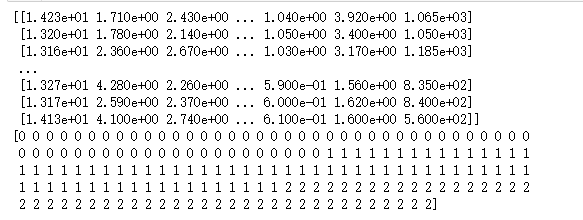
# 3.sklearn建模的基本流程
# 实例化
# 训练集代入实例化后的模型进行训练,使用的接口是fit
# 使用其它接口将测试集导入训练好的模型,获得结果(score,y_test)Xtrain, Xtest, Ytrain, Ytest = train_test_split(wine.data, wine.target, test_size=0.3)
clf = DecisionTreeClassifier(random_state=0)# random_state控制树的生成模式,random_state=0让它只能生成一棵树
rfc = RandomForestClassifier(random_state=0)# random_state也是控制随机性的,但和决策树的有些许不同
clf = clf.fit(Xtrain, Ytrain)
rfc = rfc.fit(Xtrain, Ytrain)
score_c = clf.score(Xtest, Ytest)
score_r = rfc.score(Xtest, Ytest)
print('Single Tree:{}'.format(score_c), 'Random Forest:{}'.format(score_r)# format后面()里的内容是放到前面{}里的)
输出为:

# 4.画出随机森林和决策树在一组交叉验证下的效果对比
# 复习交叉验证:将数据集划分为n份,依次取每一份做测试集,其余n-1份做训练集,多次训练模型以观测模型稳定性的方法
rfc = RandomForestClassifier(n_estimators=25)
rfc_s = cross_val_score(rfc, wine.data, wine.target, cv=10)
# 四个参数分别是:实例化好的模型,完整的特征矩阵,完整的标签,交叉验证的次数
clf = DecisionTreeClassifier()
clf_s = cross_val_score(clf, wine.data, wine.target, cv=10)
plt.plot(range(1, 11), rfc_s, label="RandomForest")
# 三个参数分别是:x的取值[1,11),y的取值,折线的标签
plt.plot(range(1, 11), clf_s, label="Decision Tree")
# 一个plot里面只能有一个标签,所以想显示折线的标签就只能写两行
plt.legend()# 显示图例
plt.show()# 展示图像
# ====================一种更加有趣也更简单的写法===================
"""
label = "RandomForest"
for model in [RandomForestClassifier(n_estimators=25),DecisionTreeClassifier()]:score = cross_val_score(model,wine.data,wine.target,cv=10)print("{}:".format(label)),print(score.mean())plt.plot(range(1,11),score,label = label)plt.legend()label = "DecisionTree"
"""
输出为:
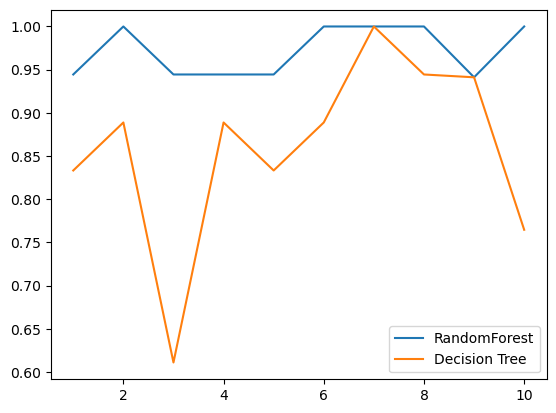
# 5.画出随即森林和决策树在十组交叉验证下的效果对比(一般这部分不用做)
rfc_l = []
clf_l = []
for i in range(10):rfc = RandomForestClassifier(n_estimators=25)rfc_s = cross_val_score(rfc, wine.data, wine.target, cv=10).mean()rfc_l.append(rfc_s)clf = DecisionTreeClassifier()clf_s = cross_val_score(clf, wine.data, wine.target, cv=10).mean()clf_l.append(clf_s)plt.plot(range(1, 11), rfc_l, label="Random Forest")
plt.plot(range(1, 11), clf_l, label="Decision Tree")
plt.legend()
plt.show()
# 是否有注意到,单个决策树的波动轨迹和随机森林一致?
# 再次验证了我们之前提到的,单个决策树的准确率越高,随机森林的准确率也会越高
输出为:
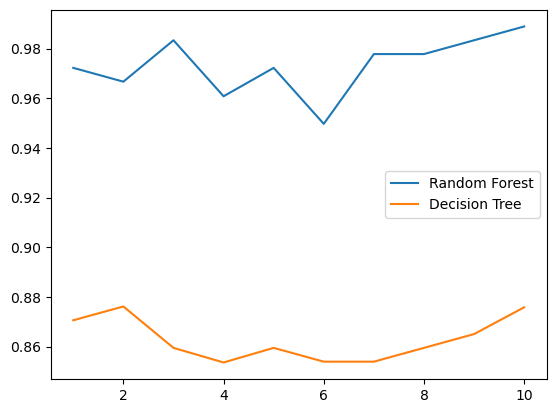
# 6.n_estimators的学习曲线
superpa = []
for i in range(200):rfc = RandomForestClassifier(n_estimators=i+1, n_jobs=-1) # 实例化rfc_s = cross_val_score(rfc, wine.data, wine.target, cv=10).mean() # 交叉验证superpa.append(rfc_s) # 将交叉验证的结果放到列表里
print(max(superpa), superpa.index(max(superpa))) # list.index(object)会返回对象object在列表list当中的索引
plt.figure(figsize=[20, 5])
plt.plot(range(1, 201), superpa)
plt.show()输出为:
0.9888888888888889 42

AdaBoost
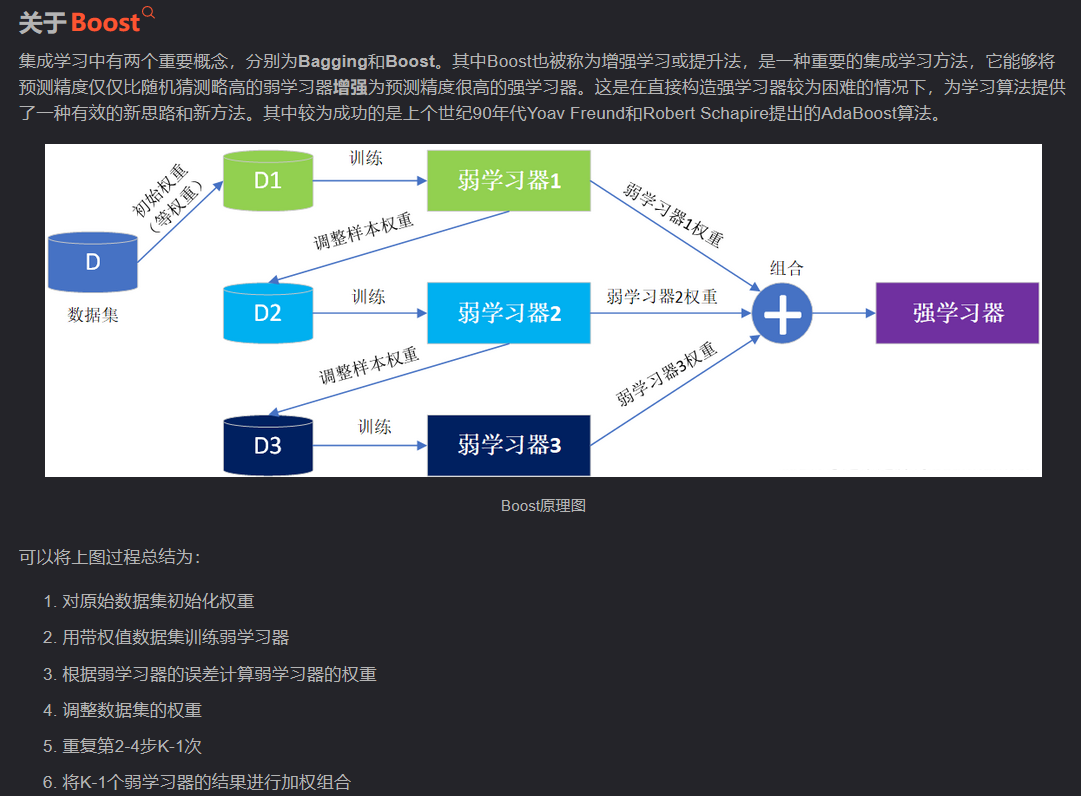
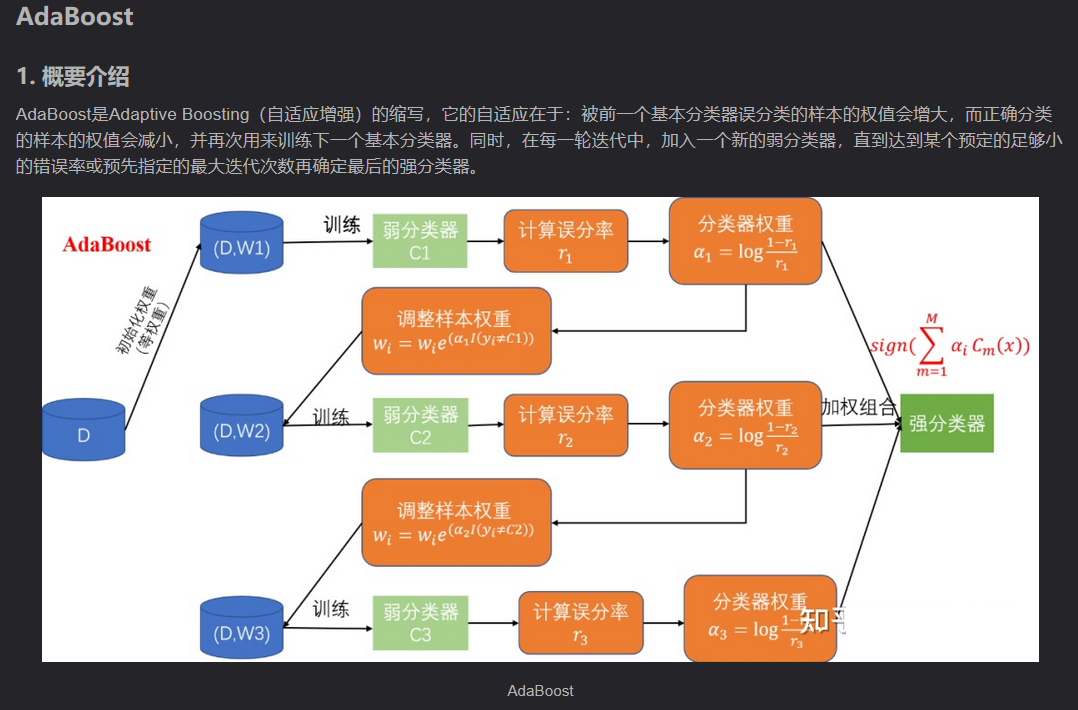

from sklearn.model_selection import cross_val_score
from sklearn.datasets import load_iris
from sklearn.ensemble import AdaBoostClassifierX, y = load_iris(return_X_y=True)
clf = AdaBoostClassifier(n_estimators=100, algorithm="SAMME",)
scores = cross_val_score(clf, X, y, cv=5)
print("scores\n",scores)
scores.mean()
print("scores.mean()\n",scores.mean())
输出为:
scores
[0.96666667 0.96666667 0.93333333 0.9 1. ]
scores.mean()
0.9533333333333334
模型融合
安装xgboost
!pip install xgboost
导入依赖
import sys
import os
print("Python version: {}". format(sys.version))
import pandas as pd # 加载csv等表格数据
print("pandas version: {}". format(pd.__version__))import matplotlib # 画图
print("matplotlib version: {}". format(matplotlib.__version__))import numpy as np #数据运算
print("NumPy version: {}". format(np.__version__))import scipy as sp #高级数学运算
print("SciPy version: {}". format(sp.__version__)) import IPython
from IPython import display #美化DataFrame的输出import sklearn #机器学习算法
print("scikit-learn version: {}". format(sklearn.__version__))#基础库
import random
import time#忽略警告
import warnings
warnings.filterwarnings('ignore')
print('-'*25)
输出为:
Python version: 3.6.3 |Anaconda custom (64-bit)| (default, Oct 15 2017, 03:27:45) [MSC v.1900 64 bit (AMD64)]
pandas version: 1.1.5
matplotlib version: 3.3.4
NumPy version: 1.17.0
SciPy version: 1.5.4
scikit-learn version: 0.24.2
-------------------------
# 常见机器学习算法
from sklearn import svm, tree, linear_model, neighbors, naive_bayes, ensemble, discriminant_analysis, gaussian_process
from xgboost import XGBClassifierfrom sklearn import datasets# 常见函数
from sklearn.preprocessing import OneHotEncoder, LabelEncoder
from sklearn import feature_selection
from sklearn import model_selection
from sklearn import metrics#可视化
import matplotlib as mpl
import matplotlib.pyplot as plt
import matplotlib.pylab as pylab
import seaborn as sns
from pandas.plotting import scatter_matrix#配置可视化
%matplotlib inline
mpl.style.use('ggplot')
sns.set_style('white')
pylab.rcParams['figure.figsize'] = 12,8
定义多个模型
MLA = [#集成方法ensemble.AdaBoostClassifier(),# ensemble.BaggingClassifier(),# ensemble.ExtraTreesClassifier(),# ensemble.GradientBoostingClassifier(),# ensemble.RandomForestClassifier(),#高斯过程# gaussian_process.GaussianProcessClassifier(),#非线性分类器linear_model.LogisticRegressionCV(),# linear_model.PassiveAggressiveClassifier(),# linear_model.RidgeClassifierCV(),linear_model.SGDClassifier(),linear_model.Perceptron(),#贝叶斯# naive_bayes.BernoulliNB(),naive_bayes.GaussianNB(),#KNN算法neighbors.KNeighborsClassifier(),#支持向量机-SVM# svm.SVC(probability=True),# svm.NuSVC(probability=True),svm.LinearSVC(),#决策树模型 tree.DecisionTreeClassifier(),# tree.ExtraTreeClassifier(),#奇异值分析# discriminant_analysis.LinearDiscriminantAnalysis(),# discriminant_analysis.QuadraticDiscriminantAnalysis(),#xgboost: http://xgboost.readthedocs.io/en/latest/model.htmlXGBClassifier() ]
定义字典
iris = datasets.load_iris()
iris.data
iris.target
# X_train, X_test, y_train, y_test = train_test_split(
# iris.data, iris.target, test_size=0.4, random_state=0)
cv_split = model_selection.ShuffleSplit(n_splits = 10, test_size = .3, train_size = .6, random_state = 0 ) # run model 10x with 60/30 split intentionally leaving out 10%#create table to compare MLA metrics
MLA_columns = ['MLA Name', 'MLA Parameters','MLA Train Accuracy Mean', 'MLA Test Accuracy Mean', 'MLA Test Accuracy 3*STD' ,'MLA Time']
MLA_compare = pd.DataFrame(columns = MLA_columns)
MLA_compare
| MLA Name | MLA Parameters | MLA Train Accuracy Mean | MLA Test Accuracy Mean | MLA Test Accuracy 3*STD | MLA Time |
|---|
使用多个模型测试
#create table to compare MLA predictions
# train['pred']=-1
MLA_predict={}
MLA_predict['true'] = iris.target#index through MLA and save performance to table
row_index = 0
for alg in MLA:#set name and parametersMLA_name = alg.__class__.__name__print(MLA_name)MLA_compare.loc[row_index, 'MLA Name'] = MLA_nameMLA_compare.loc[row_index, 'MLA Parameters'] = str(alg.get_params())cv_results = model_selection.cross_validate(alg, iris.data,iris.target, cv = cv_split,return_train_score=True)MLA_compare.loc[row_index, 'MLA Time'] = cv_results['fit_time'].mean()MLA_compare.loc[row_index, 'MLA Train Accuracy Mean'] = cv_results['train_score'].mean()MLA_compare.loc[row_index, 'MLA Test Accuracy Mean'] = cv_results['test_score'].mean() #if this is a non-bias random sample, then +/-3 standard deviations (std) from the mean, should statistically capture 99.7% of the subsetsMLA_compare.loc[row_index, 'MLA Test Accuracy 3*STD'] = cv_results['test_score'].std()*3 #let's know the worst that can happen!#save MLA predictions - see section 6 for usagealg.fit(iris.data, iris.target)MLA_predict[MLA_name] = alg.predict(iris.data)row_index+=1MLA_compare.sort_values(by = ['MLA Test Accuracy Mean'], ascending = False, inplace = True)
MLA_compare
输出为:
AdaBoostClassifier
LogisticRegressionCV
SGDClassifier
Perceptron
GaussianNB
KNeighborsClassifier
LinearSVC
DecisionTreeClassifier
XGBClassifier
MLA_predict
输出为:
{‘true’: array([0, 0, 0, 0, 0, 0, 0, 0, 0, 0, 0, 0, 0, 0, 0, 0, 0, 0, 0, 0, 0, 0,
0, 0, 0, 0, 0, 0, 0, 0, 0, 0, 0, 0, 0, 0, 0, 0, 0, 0, 0, 0, 0, 0,
0, 0, 0, 0, 0, 0, 1, 1, 1, 1, 1, 1, 1, 1, 1, 1, 1, 1, 1, 1, 1, 1,
1, 1, 1, 1, 1, 1, 1, 1, 1, 1, 1, 1, 1, 1, 1, 1, 1, 1, 1, 1, 1, 1,
1, 1, 1, 1, 1, 1, 1, 1, 1, 1, 1, 1, 2, 2, 2, 2, 2, 2, 2, 2, 2, 2,
2, 2, 2, 2, 2, 2, 2, 2, 2, 2, 2, 2, 2, 2, 2, 2, 2, 2, 2, 2, 2, 2,
2, 2, 2, 2, 2, 2, 2, 2, 2, 2, 2, 2, 2, 2, 2, 2, 2, 2]),
‘AdaBoostClassifier’: array([0, 0, 0, 0, 0, 0, 0, 0, 0, 0, 0, 0, 0, 0, 0, 0, 0, 0, 0, 0, 0, 0,
0, 0, 0, 0, 0, 0, 0, 0, 0, 0, 0, 0, 0, 0, 0, 0, 0, 0, 0, 0, 0, 0,
0, 0, 0, 0, 0, 0, 1, 1, 1, 1, 1, 1, 1, 1, 1, 1, 1, 1, 1, 1, 1, 1,
1, 1, 1, 1, 2, 1, 1, 1, 1, 1, 1, 2, 1, 1, 1, 1, 1, 1, 1, 1, 1, 1,
1, 1, 1, 1, 1, 1, 1, 1, 1, 1, 1, 1, 2, 2, 2, 2, 2, 2, 2, 2, 2, 2,
2, 2, 2, 2, 2, 2, 2, 2, 2, 1, 2, 2, 2, 2, 2, 2, 2, 2, 2, 1, 2, 2,
2, 1, 1, 2, 2, 2, 2, 2, 2, 2, 2, 2, 2, 2, 2, 2, 2, 2]),
‘LogisticRegressionCV’: array([0, 0, 0, 0, 0, 0, 0, 0, 0, 0, 0, 0, 0, 0, 0, 0, 0, 0, 0, 0, 0, 0,
0, 0, 0, 0, 0, 0, 0, 0, 0, 0, 0, 0, 0, 0, 0, 0, 0, 0, 0, 0, 0, 0,
0, 0, 0, 0, 0, 0, 1, 1, 1, 1, 1, 1, 1, 1, 1, 1, 1, 1, 1, 1, 1, 1,
1, 1, 1, 1, 2, 1, 1, 1, 1, 1, 1, 1, 1, 1, 1, 1, 1, 2, 1, 1, 1, 1,
1, 1, 1, 1, 1, 1, 1, 1, 1, 1, 1, 1, 2, 2, 2, 2, 2, 2, 2, 2, 2, 2,
2, 2, 2, 2, 2, 2, 2, 2, 2, 2, 2, 2, 2, 2, 2, 2, 2, 2, 2, 2, 2, 2,
2, 1, 2, 2, 2, 2, 2, 2, 2, 2, 2, 2, 2, 2, 2, 2, 2, 2]),
‘SGDClassifier’: array([0, 0, 0, 0, 0, 0, 0, 0, 0, 0, 0, 0, 0, 0, 0, 0, 0, 0, 0, 0, 0, 0,
0, 0, 0, 0, 0, 0, 0, 0, 0, 0, 0, 0, 0, 0, 0, 0, 0, 0, 0, 0, 0, 0,
0, 0, 0, 0, 0, 0, 0, 0, 0, 1, 2, 2, 2, 0, 0, 2, 1, 0, 1, 2, 0, 0,
2, 1, 2, 1, 2, 0, 2, 2, 0, 0, 1, 2, 2, 0, 1, 1, 0, 2, 2, 2, 0, 1,
0, 0, 2, 2, 0, 0, 2, 0, 0, 0, 0, 0, 2, 2, 2, 2, 2, 2, 2, 2, 2, 2,
2, 2, 2, 2, 2, 2, 2, 2, 2, 2, 2, 2, 2, 2, 2, 2, 2, 2, 2, 2, 2, 2,
2, 2, 2, 2, 2, 2, 2, 2, 2, 2, 2, 2, 2, 2, 2, 2, 2, 2]),
‘Perceptron’: array([1, 1, 1, 1, 1, 1, 0, 1, 1, 1, 1, 1, 1, 1, 0, 0, 0, 1, 1, 0, 1, 0,
0, 1, 1, 1, 1, 1, 1, 1, 1, 1, 0, 0, 1, 1, 1, 1, 1, 1, 1, 1, 1, 1,
1, 1, 1, 1, 1, 1, 1, 1, 1, 1, 1, 1, 1, 1, 1, 1, 1, 1, 1, 1, 1, 1,
1, 1, 1, 1, 1, 1, 1, 1, 1, 1, 1, 1, 1, 1, 1, 1, 1, 1, 1, 1, 1, 1,
1, 1, 1, 1, 1, 1, 1, 1, 1, 1, 1, 1, 2, 1, 1, 1, 2, 1, 2, 1, 1, 2,
1, 1, 1, 2, 2, 1, 1, 1, 1, 1, 1, 2, 1, 1, 1, 1, 1, 1, 1, 1, 1, 1,
2, 1, 1, 1, 2, 1, 1, 1, 2, 1, 1, 2, 2, 1, 1, 1, 2, 1]),
‘GaussianNB’: array([0, 0, 0, 0, 0, 0, 0, 0, 0, 0, 0, 0, 0, 0, 0, 0, 0, 0, 0, 0, 0, 0,
0, 0, 0, 0, 0, 0, 0, 0, 0, 0, 0, 0, 0, 0, 0, 0, 0, 0, 0, 0, 0, 0,
0, 0, 0, 0, 0, 0, 1, 1, 2, 1, 1, 1, 1, 1, 1, 1, 1, 1, 1, 1, 1, 1,
1, 1, 1, 1, 2, 1, 1, 1, 1, 1, 1, 2, 1, 1, 1, 1, 1, 1, 1, 1, 1, 1,
1, 1, 1, 1, 1, 1, 1, 1, 1, 1, 1, 1, 2, 2, 2, 2, 2, 2, 1, 2, 2, 2,
2, 2, 2, 2, 2, 2, 2, 2, 2, 1, 2, 2, 2, 2, 2, 2, 2, 2, 2, 2, 2, 2,
2, 1, 2, 2, 2, 2, 2, 2, 2, 2, 2, 2, 2, 2, 2, 2, 2, 2]),
‘KNeighborsClassifier’: array([0, 0, 0, 0, 0, 0, 0, 0, 0, 0, 0, 0, 0, 0, 0, 0, 0, 0, 0, 0, 0, 0,
0, 0, 0, 0, 0, 0, 0, 0, 0, 0, 0, 0, 0, 0, 0, 0, 0, 0, 0, 0, 0, 0,
0, 0, 0, 0, 0, 0, 1, 1, 1, 1, 1, 1, 1, 1, 1, 1, 1, 1, 1, 1, 1, 1,
1, 1, 1, 1, 2, 1, 2, 1, 1, 1, 1, 1, 1, 1, 1, 1, 1, 2, 1, 1, 1, 1,
1, 1, 1, 1, 1, 1, 1, 1, 1, 1, 1, 1, 2, 2, 2, 2, 2, 2, 1, 2, 2, 2,
2, 2, 2, 2, 2, 2, 2, 2, 2, 1, 2, 2, 2, 2, 2, 2, 2, 2, 2, 2, 2, 2,
2, 2, 2, 2, 2, 2, 2, 2, 2, 2, 2, 2, 2, 2, 2, 2, 2, 2]),
‘LinearSVC’: array([0, 0, 0, 0, 0, 0, 0, 0, 0, 0, 0, 0, 0, 0, 0, 0, 0, 0, 0, 0, 0, 0,
0, 0, 0, 0, 0, 0, 0, 0, 0, 0, 0, 0, 0, 0, 0, 0, 0, 0, 0, 0, 0, 0,
0, 0, 0, 0, 0, 0, 1, 1, 1, 1, 1, 1, 1, 1, 1, 1, 1, 1, 1, 1, 1, 1,
1, 1, 1, 1, 2, 1, 1, 1, 1, 1, 1, 1, 1, 1, 1, 1, 1, 2, 2, 1, 1, 1,
1, 1, 1, 1, 1, 1, 1, 1, 1, 1, 1, 1, 2, 2, 2, 2, 2, 2, 2, 2, 2, 2,
2, 2, 2, 2, 2, 2, 2, 2, 2, 2, 2, 2, 2, 2, 2, 2, 2, 2, 2, 1, 2, 2,
2, 1, 2, 2, 2, 2, 2, 2, 2, 2, 2, 2, 2, 2, 2, 2, 2, 2]),
‘DecisionTreeClassifier’: array([0, 0, 0, 0, 0, 0, 0, 0, 0, 0, 0, 0, 0, 0, 0, 0, 0, 0, 0, 0, 0, 0,
0, 0, 0, 0, 0, 0, 0, 0, 0, 0, 0, 0, 0, 0, 0, 0, 0, 0, 0, 0, 0, 0,
0, 0, 0, 0, 0, 0, 1, 1, 1, 1, 1, 1, 1, 1, 1, 1, 1, 1, 1, 1, 1, 1,
1, 1, 1, 1, 1, 1, 1, 1, 1, 1, 1, 1, 1, 1, 1, 1, 1, 1, 1, 1, 1, 1,
1, 1, 1, 1, 1, 1, 1, 1, 1, 1, 1, 1, 2, 2, 2, 2, 2, 2, 2, 2, 2, 2,
2, 2, 2, 2, 2, 2, 2, 2, 2, 2, 2, 2, 2, 2, 2, 2, 2, 2, 2, 2, 2, 2,
2, 2, 2, 2, 2, 2, 2, 2, 2, 2, 2, 2, 2, 2, 2, 2, 2, 2]),
‘XGBClassifier’: array([0, 0, 0, 0, 0, 0, 0, 0, 0, 0, 0, 0, 0, 0, 0, 0, 0, 0, 0, 0, 0, 0,
0, 0, 0, 0, 0, 0, 0, 0, 0, 0, 0, 0, 0, 0, 0, 0, 0, 0, 0, 0, 0, 0,
0, 0, 0, 0, 0, 0, 1, 1, 1, 1, 1, 1, 1, 1, 1, 1, 1, 1, 1, 1, 1, 1,
1, 1, 1, 1, 1, 1, 1, 1, 1, 1, 1, 1, 1, 1, 1, 1, 1, 1, 1, 1, 1, 1,
1, 1, 1, 1, 1, 1, 1, 1, 1, 1, 1, 1, 2, 2, 2, 2, 2, 2, 2, 2, 2, 2,
2, 2, 2, 2, 2, 2, 2, 2, 2, 2, 2, 2, 2, 2, 2, 2, 2, 2, 2, 2, 2, 2,
2, 2, 2, 2, 2, 2, 2, 2, 2, 2, 2, 2, 2, 2, 2, 2, 2, 2], dtype=int64)}
cv_results
输出为:
{‘fit_time’: array([1.16533065, 0.02996469, 0.03700185, 0.03500032, 0.02999783,
0.03499651, 0.03400135, 0.03099895, 0.03699994, 0.0380013 ]),
‘score_time’: array([0. , 0. , 0.00099874, 0.00100255, 0. ,
0. , 0.00099492, 0. , 0.00100017, 0.00099897]),
‘test_score’: array([0.97777778, 0.91111111, 0.95555556, 0.93333333, 0.97777778,
0.91111111, 0.97777778, 1. , 0.97777778, 0.97777778]),
‘train_score’: array([1., 1., 1., 1., 1., 1., 1., 1., 1., 1.])}
进行绘图:
#柱状图 https://seaborn.pydata.org/generated/seaborn.barplot.html
sns.barplot(x='MLA Test Accuracy Mean', y = 'MLA Name', data = MLA_compare, color = 'm')#pyplot 美化: https://matplotlib.org/api/pyplot_api.html
plt.title('Machine Learning Algorithm Accuracy Score \n')
plt.xlabel('Accuracy Score (%)')
plt.ylabel('Algorithm')
输出为:
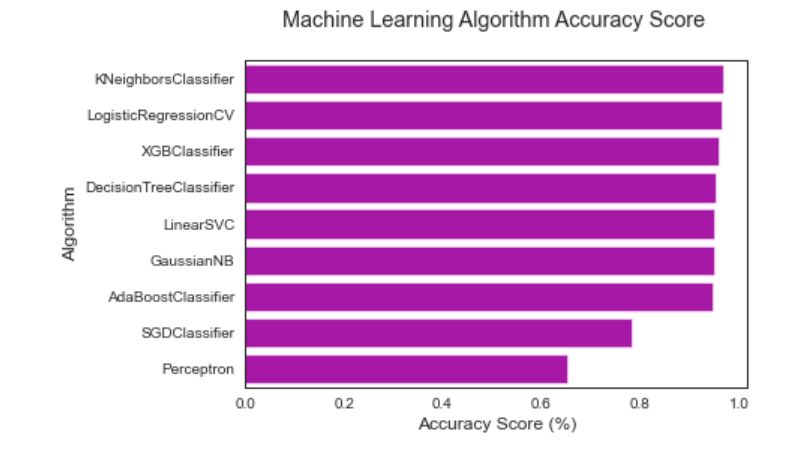
多个模型投票
vote_est = [#Ensemble Methods: http://scikit-learn.org/stable/modules/ensemble.html('ada', ensemble.AdaBoostClassifier()),# ('bc', ensemble.BaggingClassifier()),# ('etc',ensemble.ExtraTreesClassifier()),# ('gbc', ensemble.GradientBoostingClassifier()),# ('rfc', ensemble.RandomForestClassifier()),#Gaussian Processes: http://scikit-learn.org/stable/modules/gaussian_process.html#gaussian-process-classification-gpc# ('gpc', gaussian_process.GaussianProcessClassifier()),#GLM: http://scikit-learn.org/stable/modules/linear_model.html#logistic-regression('lr', linear_model.LogisticRegressionCV()),#Navies Bayes: http://scikit-learn.org/stable/modules/naive_bayes.html# ('bnb', naive_bayes.BernoulliNB()),('gnb', naive_bayes.GaussianNB()),#Nearest Neighbor: http://scikit-learn.org/stable/modules/neighbors.html('knn', neighbors.KNeighborsClassifier()),#SVM: http://scikit-learn.org/stable/modules/svm.html('svc', svm.SVC(probability=True)),('xgb', XGBClassifier())]# iris.data,iris.target
#多数投票
vote_hard = ensemble.VotingClassifier(estimators = vote_est , voting = 'hard')
vote_hard_cv = model_selection.cross_validate(vote_hard, iris.data,iris.target, cv = cv_split,return_train_score=True)
vote_hard.fit(iris.data,iris.target)print("vote_hard.predict(iris.data)\n",vote_hard.predict(iris.data))print("vote_hard_cv\n")
for k,v in vote_hard_cv.items():print(k," ",v)print("Hard Voting Training w/bin score mean: {:.2f}". format(vote_hard_cv['train_score'].mean()*100))
print("Hard Voting Test w/bin score mean: {:.2f}". format(vote_hard_cv['test_score'].mean()*100))
print("Hard Voting Test w/bin score 3*std: +/- {:.2f}". format(vote_hard_cv['test_score'].std()*100*3))
print('-'*10)#权重投票
vote_soft = ensemble.VotingClassifier(estimators = vote_est , voting = 'soft')
vote_soft_cv = model_selection.cross_validate(vote_soft, iris.data,iris.target, cv = cv_split,return_train_score=True)
vote_soft.fit(iris.data,iris.target)
print("vote_soft.predict(iris.data)\n",vote_soft.predict(iris.data))
print("vote_soft_cv\n")
for k,v in vote_soft_cv.items():print(k," ",v)print("Soft Voting Training w/bin score mean:{:.2f}". format(vote_soft_cv['train_score'].mean()*100))
print("Soft Voting Test w/bin score mean: {:.2f}". format(vote_soft_cv['test_score'].mean()*100))
print("Soft Voting Test w/bin score 3*std: +/- {:.2f}". format(vote_soft_cv['test_score'].std()*100*3))
print('-'*10)
输出为:

完整代码
import sys
import os
print("Python version: {}". format(sys.version))
import pandas as pd # 加载csv等表格数据
print("pandas version: {}". format(pd.__version__))import matplotlib # 画图
print("matplotlib version: {}". format(matplotlib.__version__))import numpy as np #数据运算
print("NumPy version: {}". format(np.__version__))import scipy as sp #高级数学运算
print("SciPy version: {}". format(sp.__version__)) import IPython
from IPython import display #美化DataFrame的输出import sklearn #机器学习算法
print("scikit-learn version: {}". format(sklearn.__version__))#基础库
import random
import time#忽略警告
import warnings
warnings.filterwarnings('ignore')
print('-'*25)# 常见机器学习算法
from sklearn import svm, tree, linear_model, neighbors, naive_bayes, ensemble, discriminant_analysis, gaussian_process
from xgboost import XGBClassifierfrom sklearn import datasets# 常见函数
from sklearn.preprocessing import OneHotEncoder, LabelEncoder
from sklearn import feature_selection
from sklearn import model_selection
from sklearn import metrics#可视化
import matplotlib as mpl
import matplotlib.pyplot as plt
import matplotlib.pylab as pylab
import seaborn as sns
from pandas.plotting import scatter_matrix#配置可视化
%matplotlib inline
mpl.style.use('ggplot')
sns.set_style('white')
pylab.rcParams['figure.figsize'] = 12,8MLA = [#集成方法ensemble.AdaBoostClassifier(),# ensemble.BaggingClassifier(),# ensemble.ExtraTreesClassifier(),# ensemble.GradientBoostingClassifier(),# ensemble.RandomForestClassifier(),#高斯过程# gaussian_process.GaussianProcessClassifier(),#非线性分类器linear_model.LogisticRegressionCV(),# linear_model.PassiveAggressiveClassifier(),# linear_model.RidgeClassifierCV(),linear_model.SGDClassifier(),linear_model.Perceptron(),#贝叶斯# naive_bayes.BernoulliNB(),naive_bayes.GaussianNB(),#KNN算法neighbors.KNeighborsClassifier(),#支持向量机-SVM# svm.SVC(probability=True),# svm.NuSVC(probability=True),svm.LinearSVC(),#决策树模型 tree.DecisionTreeClassifier(),# tree.ExtraTreeClassifier(),#奇异值分析# discriminant_analysis.LinearDiscriminantAnalysis(),# discriminant_analysis.QuadraticDiscriminantAnalysis(),#xgboost: http://xgboost.readthedocs.io/en/latest/model.htmlXGBClassifier() ]iris = datasets.load_iris()
iris.data
iris.target
# X_train, X_test, y_train, y_test = train_test_split(
# iris.data, iris.target, test_size=0.4, random_state=0)
cv_split = model_selection.ShuffleSplit(n_splits = 10, test_size = .3, train_size = .6, random_state = 0 ) # run model 10x with 60/30 split intentionally leaving out 10%#create table to compare MLA metrics
MLA_columns = ['MLA Name', 'MLA Parameters','MLA Train Accuracy Mean', 'MLA Test Accuracy Mean', 'MLA Test Accuracy 3*STD' ,'MLA Time']
MLA_compare = pd.DataFrame(columns = MLA_columns)
MLA_compare#create table to compare MLA predictions
# train['pred']=-1
MLA_predict={}
MLA_predict['true'] = iris.target#index through MLA and save performance to table
row_index = 0
for alg in MLA:#set name and parametersMLA_name = alg.__class__.__name__print(MLA_name)MLA_compare.loc[row_index, 'MLA Name'] = MLA_nameMLA_compare.loc[row_index, 'MLA Parameters'] = str(alg.get_params())cv_results = model_selection.cross_validate(alg, iris.data,iris.target, cv = cv_split,return_train_score=True)MLA_compare.loc[row_index, 'MLA Time'] = cv_results['fit_time'].mean()MLA_compare.loc[row_index, 'MLA Train Accuracy Mean'] = cv_results['train_score'].mean()MLA_compare.loc[row_index, 'MLA Test Accuracy Mean'] = cv_results['test_score'].mean() #if this is a non-bias random sample, then +/-3 standard deviations (std) from the mean, should statistically capture 99.7% of the subsetsMLA_compare.loc[row_index, 'MLA Test Accuracy 3*STD'] = cv_results['test_score'].std()*3 #let's know the worst that can happen!#save MLA predictions - see section 6 for usagealg.fit(iris.data, iris.target)MLA_predict[MLA_name] = alg.predict(iris.data)row_index+=1MLA_compare.sort_values(by = ['MLA Test Accuracy Mean'], ascending = False, inplace = True)
MLA_compareMLA_predictcv_results#柱状图 https://seaborn.pydata.org/generated/seaborn.barplot.html
sns.barplot(x='MLA Test Accuracy Mean', y = 'MLA Name', data = MLA_compare, color = 'm')#pyplot 美化: https://matplotlib.org/api/pyplot_api.html
plt.title('Machine Learning Algorithm Accuracy Score \n')
plt.xlabel('Accuracy Score (%)')
plt.ylabel('Algorithm')vote_est = [#Ensemble Methods: http://scikit-learn.org/stable/modules/ensemble.html('ada', ensemble.AdaBoostClassifier()),# ('bc', ensemble.BaggingClassifier()),# ('etc',ensemble.ExtraTreesClassifier()),# ('gbc', ensemble.GradientBoostingClassifier()),# ('rfc', ensemble.RandomForestClassifier()),#Gaussian Processes: http://scikit-learn.org/stable/modules/gaussian_process.html#gaussian-process-classification-gpc# ('gpc', gaussian_process.GaussianProcessClassifier()),#GLM: http://scikit-learn.org/stable/modules/linear_model.html#logistic-regression('lr', linear_model.LogisticRegressionCV()),#Navies Bayes: http://scikit-learn.org/stable/modules/naive_bayes.html# ('bnb', naive_bayes.BernoulliNB()),('gnb', naive_bayes.GaussianNB()),#Nearest Neighbor: http://scikit-learn.org/stable/modules/neighbors.html('knn', neighbors.KNeighborsClassifier()),#SVM: http://scikit-learn.org/stable/modules/svm.html('svc', svm.SVC(probability=True)),('xgb', XGBClassifier())]# iris.data,iris.target
#多数投票
vote_hard = ensemble.VotingClassifier(estimators = vote_est , voting = 'hard')
vote_hard_cv = model_selection.cross_validate(vote_hard, iris.data,iris.target, cv = cv_split,return_train_score=True)
vote_hard.fit(iris.data,iris.target)print("vote_hard.predict(iris.data)\n",vote_hard.predict(iris.data))print("vote_hard_cv\n")
for k,v in vote_hard_cv.items():print(k," ",v)print("Hard Voting Training w/bin score mean: {:.2f}". format(vote_hard_cv['train_score'].mean()*100))
print("Hard Voting Test w/bin score mean: {:.2f}". format(vote_hard_cv['test_score'].mean()*100))
print("Hard Voting Test w/bin score 3*std: +/- {:.2f}". format(vote_hard_cv['test_score'].std()*100*3))
print('-'*10)#权重投票
vote_soft = ensemble.VotingClassifier(estimators = vote_est , voting = 'soft')
vote_soft_cv = model_selection.cross_validate(vote_soft, iris.data,iris.target, cv = cv_split,return_train_score=True)
vote_soft.fit(iris.data,iris.target)
print("vote_soft.predict(iris.data)\n",vote_soft.predict(iris.data))
print("vote_soft_cv\n")
for k,v in vote_soft_cv.items():print(k," ",v)print("Soft Voting Training w/bin score mean:{:.2f}". format(vote_soft_cv['train_score'].mean()*100))
print("Soft Voting Test w/bin score mean: {:.2f}". format(vote_soft_cv['test_score'].mean()*100))
print("Soft Voting Test w/bin score 3*std: +/- {:.2f}". format(vote_soft_cv['test_score'].std()*100*3))
print('-'*10)


原子操作 | 11.4、通过内存序实现顺序模型)




的介绍(STM32F4))









 生产者消费者模型)
)

